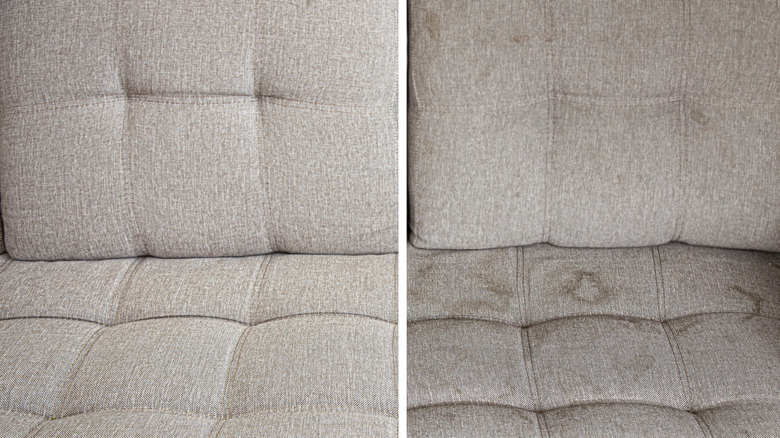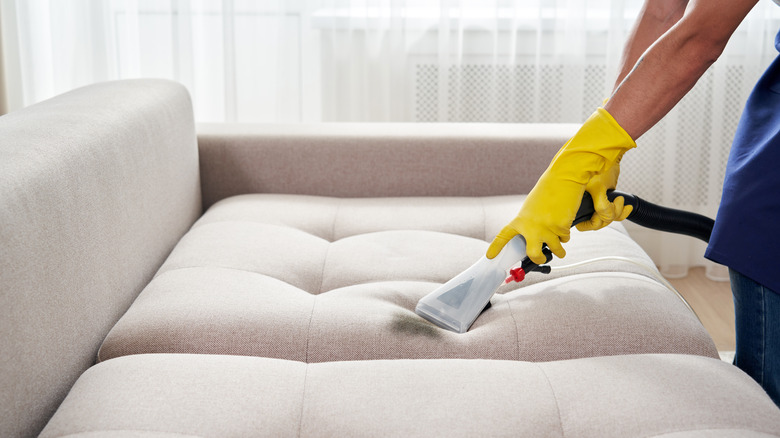Here's How Often You Need To Clean Your Sofa
Sofas are a staple in every living room, and lately, we've been using them more than ever. Despite the fact that we spend hours each day lounging on these pieces of furniture, we may clean them much less than we should.
How often you should clean your sofa depends on how much use it gets. If you have children and pets that use the sofa regularly, then you'll probably want your sofa more frequently. If you don't have kids or pets that sit on the couch, however, you can get away with doing it less often. You can also look at the color of the fabric. If your couch is white or light-colored, then it should be cleaned often because dirt shows up more on lighter fabrics. If your couch is a dark color like black or brown, then you can go longer between cleanings because dirt doesn't show up as easily on dark fabrics.
Just like cleaning your bedding, cleaning your couch can help remove dust mites, pet dander, and other allergens. According to Wirecutter, sofas can also become dingy over time if they aren't cleaned regularly — so cleaning them is important for both hygiene and aesthetics. Unfortunately, a quick once-over with the vacuum cleaner will not cut it.
How often should you clean your sofa?
How often you should clean your sofa depends on several factors, but Edgar Blazona, who founded of BenchMade Modern, told Martha Stewart that — generally speaking — sofas should be deep cleaned twice a year. He says, "I recommend doing a deep clean of your sofa every six months, just like you would your rugs." In fact, he recommended trying to include upholstery cleaning in the quote if you have your rugs professionally cleaned on an annual basis.
If the fabric is something that attracts a lot of dust or dirt or has loose cushions that you can easily remove for washing, you should clean it more frequently. Blazona recommends cleaning your couch once a week, saying, "Use your vacuum to clean the cushions, arms, and under the cushions, once a week to get rid of any dirt, dust, or crumbs that may have accumulated." You'll also want to be sure to clean up any spills as soon as possible to prevent them from staining and ensure that they don't get ground into the fabric and become harder to remove over time.
Leather sofas will need to be cleaned less than fabric sofas because they're less likely to harbor allergens and bacteria. However, dirt can still build up over time and cause your leather to lose its luster.
Deciphering upholstery cleaning codes
The first step to cleaning a sofa is identifying the fabric type. Different materials require different cleaning methods and solutions, so knowing what you're working with can help save time and prevent damage. Luckily, manufacturers typically list upholstery cleaning codes on furniture tags, so finding your code should be relatively easy. The cleaning code, often found on a white tag stitched into the underside of your sofa, is a letter or combination of letters that let you know the best method to clean your sofa.
These four common letter codes are intended to give consumers an idea of how to clean their furniture without damaging it, but they can be confusing. The first code letter, "W," stands for water-based cleaners, according to Wirecutter. The second, "S," indicates a solvent-based cleaner. The third, "S/W" means you can use either type of cleaner. And the final letter "X" is used to indicate whether a vacuum cleaner or brush is the best tool for cleaning it. If your sofa doesn't have a tag or if it has one, but you're unsure what type of upholstery you have, check with your dealer or take a sample to a professional upholstery cleaning service for advice.
How to clean a sofa
A leather sofa is one of the easiest to clean because dirt doesn't get caught deep in the fabric. All that's required is a wipe down with a damp cloth, using a leather conditioner to remove dust, pet hair, and anything else that has gotten stuck to it.
Fabric sofas are tougher to clean because dirt can be ground into the fibers. They should be vacuumed regularly using the upholstery attachment. This involves taking off all the cushions, vacuuming the back, under cushions, and sides along the frame. Start at the top and work your way down, paying close attention to any folds or creases that may have collected dirt or dust.
Sofas with removable covers can often be machine washed, according to Revolution Fabrics. It's usually best to allow cushion covers to hang dry rather than putting them in the dryer to prevent the fabric from shrinking.
If your covers aren't removable, the sofa will need to be spot cleaned. Apply a cleaning solution as dictated by the fabric label. A mix of mild dish soap and warm water will work for most stains, though you can use a commercial cleaner if you prefer. If you're using a store-bought cleaner, make sure it's safe for your particular fabric before applying it.



